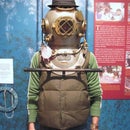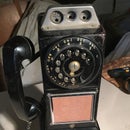Introduction: Make Circuit Boards With Lasers
A homemade circuit board is only as good as the mask you put onto it. No matter what method you use to do the actual etching, you still need to stick an image of your circuit onto the board, and make sure it leaves crisp, clean, solid traces behind when the exposed copper dissolves. That's harder than it sounds.
There are lots of ways to add a mask to copper board—permanent markers, vinyl stickers, toner transfer, and more. Each one gives decent results, but can be messy and/or time consuming..
The good news? If you have access to a laser cutter or engraver, there's a MUCH easier way! With some black spray paint and an image of your board, the precision of a laser will make a professional-quality mask in just a few minutes.
You'll need:
- A completed single-sided circuit board design (I used Autodesk Eagle to make mine.)
- Access to a laser cutter or engraver
- 1 package copper clad board (single sided)
- 1 can black spray paint, matte or flat finish
- latex gloves or rubber dish gloves (optional)
Step 1: Export Your Board Layout As a PNG File.
Export your circuit design as a PNG file from whatever software you used. Be sure it's ACTUAL SIZE, not scaled larger or smaller, so your components fit. You can check by printing the image on regular paper, and poking components through the holes - if the parts fit, you're in good shape.
If you used Eagle like I did, here's a mini tutorial on how to export:
- Click on the "layer settings" button. (looks like three multicolor squares).
- Make sure that ONLY the traces and pads on bottom of the board are displayed. This is the stuff that you want to physically see etched on your board. Usually this will be layer 16 ("Bottom"), 17 ("Pads"), 18 ("Vias"), and 20 ("Dimension)".
- Under the "file" menu, select "export", then "image".
- Set resolution to 1200 dpi, and BE SURE to select "monochrome." Give the file a name, and save it.
- Finally, INVERT THE COLORS of your file. Anything that was black should now be white, and vice-versa. You can do this in most image editing software (for instance, there's a one-click "invert" command in photoshop or GIMP.
- Save the image as a PNG file.
Step 2: Spraypaint the Blank PCB
Next, prepare the blank copper clad boards. I didn't take many photos of this step, but it's pretty straightforward.
Wipe down a few blank boards with acetone to clean off any oil from your fingers. Wait for it to dry, then lay them down on a piece of clean scrap paper. Apply a 2-3 coats of black spray paint to each one. Go easy - a few light layers is better than one thick one. You want the paint to go on as evenly (and dust-free) as possible, with no drips or runs.
Ultimately, we'll be using the laser cutter to burn off the paint in the spots where you want to etch the copper... so the more uniform the surface, the better the result.
Step 3: Burn in Circuit Design Using Laser Cutter
Pew pew! Time for lasers!
- Load the INVERTED COLOR PNG file into your laser cutter's control software.
- Set up the software to etch rather than cut. The laser remove anything that's black in the image, and will leave the white space (the stuff that will become your mask).
- Lay one of the painted copper boards into the cutter bed, with the black side facing up.
- Make sure to set things up so the laser doesn't burn past the edge of your board. I found it helpful to push the board into the very top left corner of the laser cutter's platform, and nudge it against the ruler guides on the cutter's platform. Your cutter may be different, though.
- Etch away!
You may have to play with the settings a bit to get this to etch correctly, so it's helpful to paint a couple of extra boards to use for trial runs. Lasering off the paint doesn't remove any of the copper, so you can always go strip it and re-coat for another try. Just make sure your cutter has a good ventilation fan.
Step 4: Etch Away!
Now you're ready to etch! Use whatever method you want—ferric chloride, ammonium persulfate, etc. If you don't want to deal with gnarly chemicals, you can also etch more safely with common kitchen supplies. (Check out my other instructable on how to do that here!)
When you're done, clean off any remaining paint with acetone, drill some holes, and you're all set to solder components. Happy etching!






